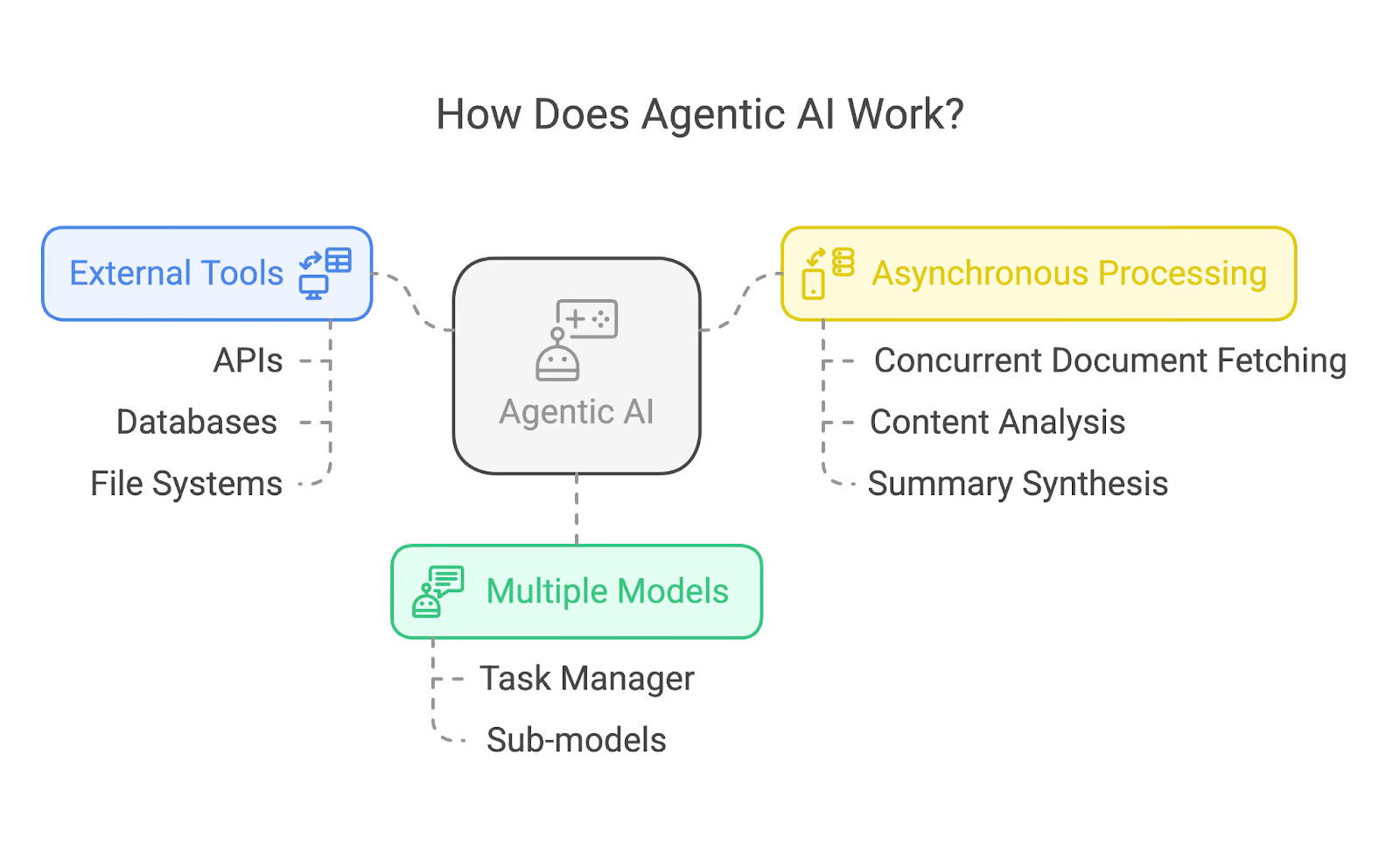Track
AI is moving beyond just responding to prompts with text or images. The next big step is agentic AI, which gives AI systems the ability to understand their environment, set goals, and take action to achieve them.
According to a recent report by Gartner, less than 1% of enterprise software applications used agentic AI techniques in 2024. According to the report, that number could rise to 33% by 2028. This means that more and more businesses are starting to see great value in agentic AI and hopefully after reading this article you will see why.
What Is Agentic AI?
There is currently no universally agreed-upon definition of agentic AI. Some people use the terms "agentic AI" and "AI agents" interchangeably, while others draw distinctions between them. Despite these differences, most agree on certain aspects of agentic AI.
Agentic AI refers to AI systems that can operate with a degree of independence, making decisions and taking actions to achieve specific goals. Unlike traditional AI, which requires explicit prompts to generate results, agentic AI can analyze situations, develop strategies, and execute tasks in parallel. Agentic AI applications maintain control of how they accomplish tasks by using tools and making decisions about internal processes.
Introduction to AI Agents
Some key aspects that define agentic AI include:
- Autonomy: The ability to function without continuous human interaction.
- Goal-oriented behavior: Setting and pursuing objectives based on predefined or evolving goals.
- Adaptability: Responding to changing environments and learning from past interactions.
- Interoperability: Ability to use different data sources, tools, and platforms to enhance decision-making.
To better understand what agentic AI is, think of an autonomous vehicle that continuously recalculates the optimal route (for speed or economy) to its destination as conditions change. This demonstrates autonomy in decision-making, goal-oriented behavior by maintaining focus on reaching the destination, adaptability to changing road conditions, and interoperability with existing infrastructure like roads, traffic signals, and real-time traffic data.

Agentic AI vs. Traditional AI
The difference between traditional AI and agentic AI comes down to autonomy and adaptability.
Traditional AI is designed for specific tasks based on predefined rules or training data. These models analyze input and return outputs but don’t make independent decisions beyond their programming. Examples include recommendation systems, chatbots, and predictive models.
Agentic AI goes beyond passive responses by actively planning, adapting, and making decisions in real time. It can interact with multiple systems, use external tools, and even refine its own objectives. Instead of waiting for user input, it can initiate tasks, learn from feedback, and self-improve.
|
Feature |
Traditional AI |
Agentic AI |
|
Autonomy |
Responds to input but does not act independently |
Can operate independently, initiate actions, and adapt to changing conditions |
|
Decision-Making |
Follows predefined rules and models |
Can refine objectives, learn from feedback, and adjust strategies |
|
Interaction |
Processes input and returns output |
Engages with multiple systems, tools, and external APIs |
|
Learning |
Requires retraining to improve performance |
Can self-improve and optimize workflows dynamically |
|
Flexibility |
Designed for specific tasks (e.g., chatbots, recommendation engines) |
Can handle complex, multi-step processes with dynamic goal-setting |
|
Use Cases |
Predictive analytics, automation, classification |
Autonomous research, task delegation, real-time adaptation |
|
Limitations |
Limited to predefined functions, lacks adaptability |
Requires careful oversight, higher risk of unintended outcomes |
How Does Agentic AI Work?
Agentic AI isn’t a single technology but a way of designing AI systems that operate with more independence than traditional models. The details vary from one application to another, but most agentic AI systems involve multiple LLMs that communicate through prompts, use external tools, and can read and write files. These systems often work asynchronously, making them feel more like distributed networks than isolated models.

Multiple models, multiple roles
In most cases, an agentic AI system isn’t just one LLM running alone—it’s a set of models interacting with each other. A common setup involves assigning distinct roles to different models.
For example, one model might act as a task manager, breaking down complex problems and distributing subtasks to other models. These sub-models then complete their assigned work and pass their output back to the task manager for evaluation and integration.
This modular approach allows agentic AI to handle more complex workflows than a single model could manage on its own. Instead of processing everything sequentially, tasks can run in parallel, making the system more responsive.
External tools and data handling
To function beyond text generation, agentic AI needs access to external tools. These could be APIs for retrieving real-world data, databases for storing information, or even file systems for reading and writing documents.
Some frameworks, like LangChain and LlamaIndex, make it easier to connect LLMs to these tools, allowing them to query databases, retrieve search results, or even interact with software applications.
Asynchronous processing and distributed architecture
Unlike traditional AI applications that process input in a linear fashion, agentic AI often operates asynchronously. Multiple models can work on different parts of a problem at the same time, which can give these systems a decentralized, blockchain-like feel.
For example, in an AI-powered research assistant, one model might fetch relevant documents while another analyzes their contents, and yet another synthesizes a summary—all happening concurrently. This kind of parallel processing makes agentic AI more efficient but also introduces challenges in coordinating outputs and maintaining consistency.
Applications of Agentic AI
I see agentic AI becoming useful across a wide range of industries. Startups are already building specialized applications, and even though the field is still taking shape, older companies are moving quickly to adopt these systems. Agentic AI can either operate independently or assist a human expert, depending on the context.
Healthcare
In healthcare, an agentic AI system could collect and monitor patient data, flag unusual patterns, and suggest possible treatments to doctors. This wouldn’t replace medical professionals but could reduce their workload and improve decision-making. AI-driven diagnostics and monitoring tools are already in use, and as agentic systems improve, they could take on more complex tasks.
Gaming
In gaming, agentic AI could replace scripted behaviors with non-player characters (NPCs) that react to players in a more natural way. Instead of predictable dialogue trees, these characters could adapt to player choices, develop goals, and even learn from past interactions. This would make in-game worlds feel more unpredictable and immersive.
Finance
Agentic AI is also being explored in finance, particularly for real-time trading. A system like this could analyze market trends, execute trades automatically, or suggest investment strategies to human traders. While some automated trading already exists, agentic AI could handle more complex decision-making without constant human input.
Benefits of Agentic AI
I think the main benefit of agentic AI is that it can help humans from routine work so they can focus on higher-level tasks. This has happened before—calculators took over tedious math, computers automated data processing, etc.
By automating repetitive work, agentic AI creates more space for experimentation. When professionals don’t have to spend hours on administrative tasks or low-level decision-making, they can iterate on ideas faster, test new approaches, and push boundaries in their fields. The speed at which new discoveries and innovations emerge could increase as a result.
Another major benefit is how agentic AI democratizes access to specialized knowledge. Historically, deep expertise was limited to those who could afford consultants, advisors, or in-house specialists. With AI-driven systems offering research, analysis, and decision-making support, smaller teams and individuals can operate at a higher level than before. This could lower barriers in industries where experience and expertise have traditionally been gatekept.
Challenges of Agentic AI
Despite its advantages, agentic AI presents significant challenges that need careful consideration. These range from ethical concerns to socio-economic disruptions and technical limitations.

Ethical concerns and regulation
One of the biggest challenges is the ethical implications of AI making autonomous decisions that affect human lives. Without clear laws and guidelines, there’s a risk of unintended harm. Until we develop robust legal frameworks and gain more real-world experience, it may be wise to limit agentic AI to assistant-based roles rather than allowing it to take direct actions with serious consequences.
AI Ethics
Socio-economic impact
Agentic AI has the potential to automate routine tasks, freeing up workers for more meaningful roles. However, this shift could also lead to widespread job displacement, creating economic and social challenges. Historically, technological revolutions have resulted in new job opportunities, but the transition period can be disruptive. Addressing this requires proactive policies and reskilling initiatives.
Technical challenges and AI transparency
The “black box” nature of AI is already a concern, and as agentic AI becomes more complex, understanding its decision-making processes will become even harder. A lack of transparency makes accountability difficult, especially when AI-driven decisions have real-world consequences.
The Future of Agentic AI
While today’s systems mostly automate predefined tasks, future models will likely go further—self-improving, setting their own objectives, and becoming more independent problem-solvers.
Autonomous and self-improving systems
Right now, agentic AI follows human-set goals, but future versions may evolve dynamically. Instead of just executing tasks, they could refine their own strategies, learn from failures, and adjust their objectives based on changing conditions. This could lead to AI systems that act more like true digital collaborators rather than just tools.
More accessible development tools
As AI development platforms improve, non-technical users will gain access to more intuitive ways of creating AI assistants. Instead of needing to code complex workflows, people will be able to design AI-powered helpers through simple interfaces. These could manage emails, automate business operations, or even handle complex project coordination—all without requiring deep technical knowledge.
AI as a personalized digital partner
The long-term vision for agentic AI isn’t just automation but personal adaptation. AI systems will likely become more individualized, learning a user’s preferences and working style to provide customized support. Instead of a one-size-fits-all AI, each person could have a system that understands their unique needs and evolves alongside them.
Conclusion
In this overview, we covered agentic AI and its applications. We also talked about benefits, challenges and gave a modest forecast of the future. Although still in its early stages, agentic AI is already gaining traction with a lot of people working in the field and developing more and more capable applications. It's an exciting area to keep an eye on, and I can't wait to see what developments come next!
To learn more, I recommend this blog on agentic RAG.
